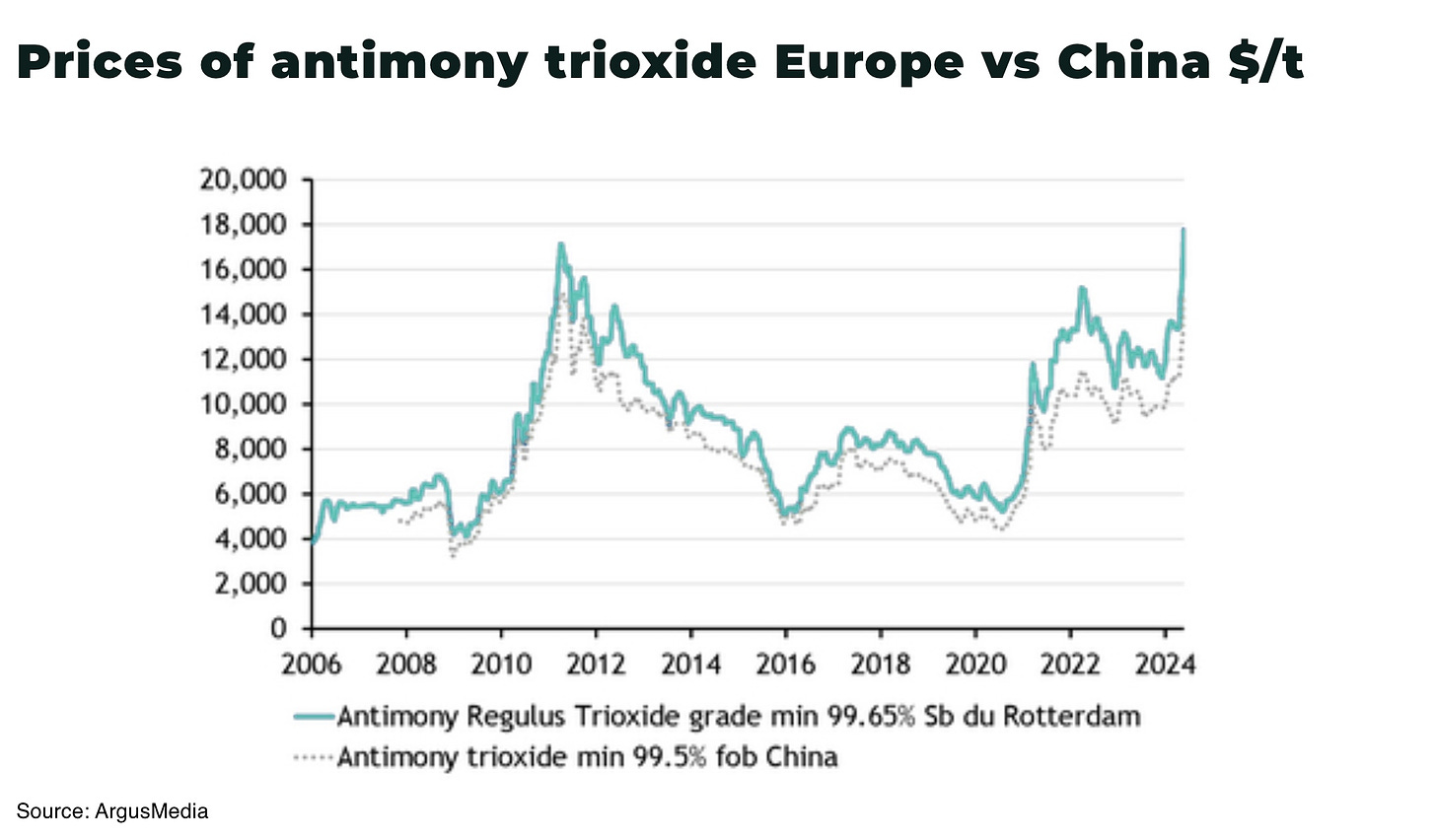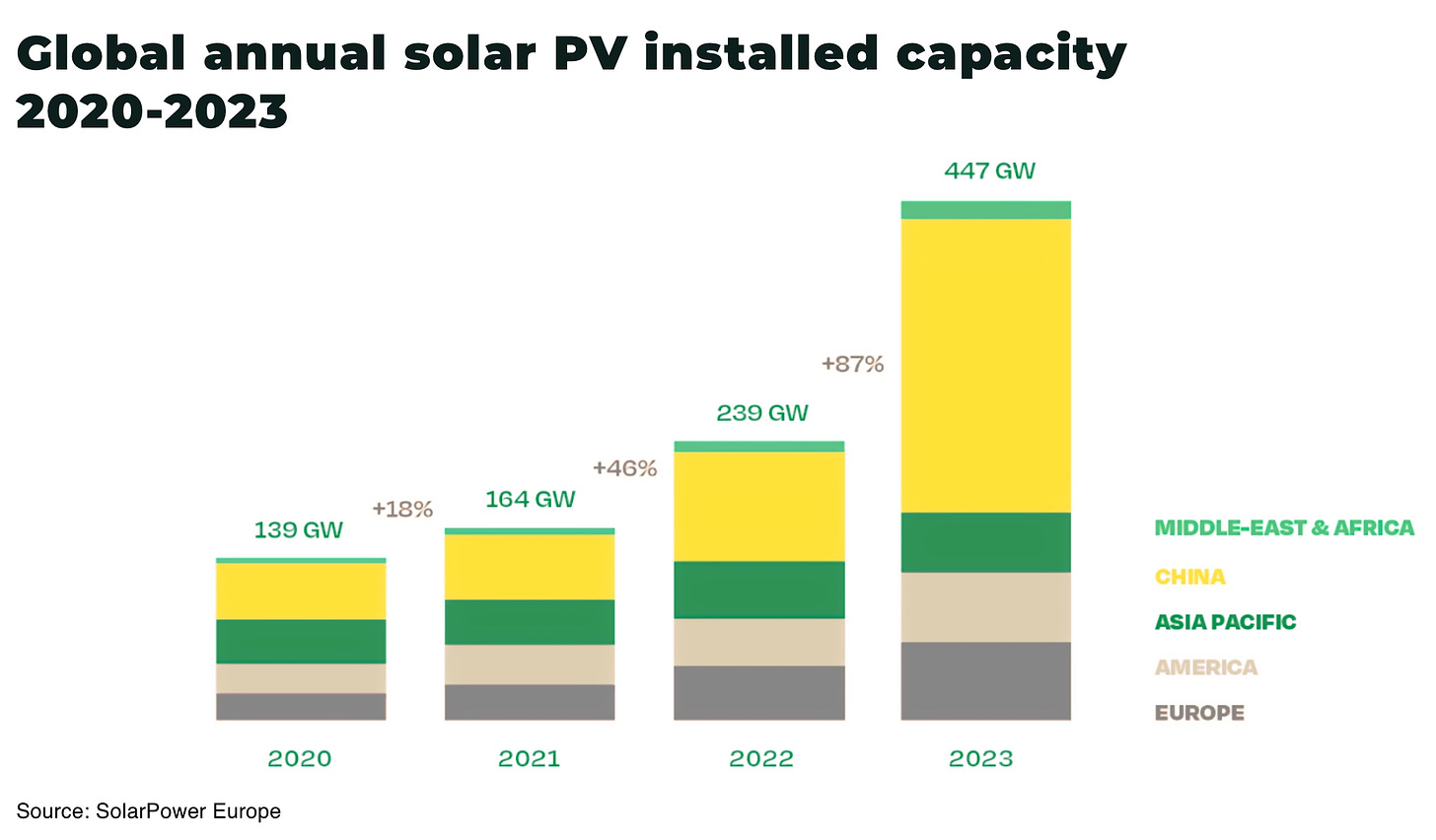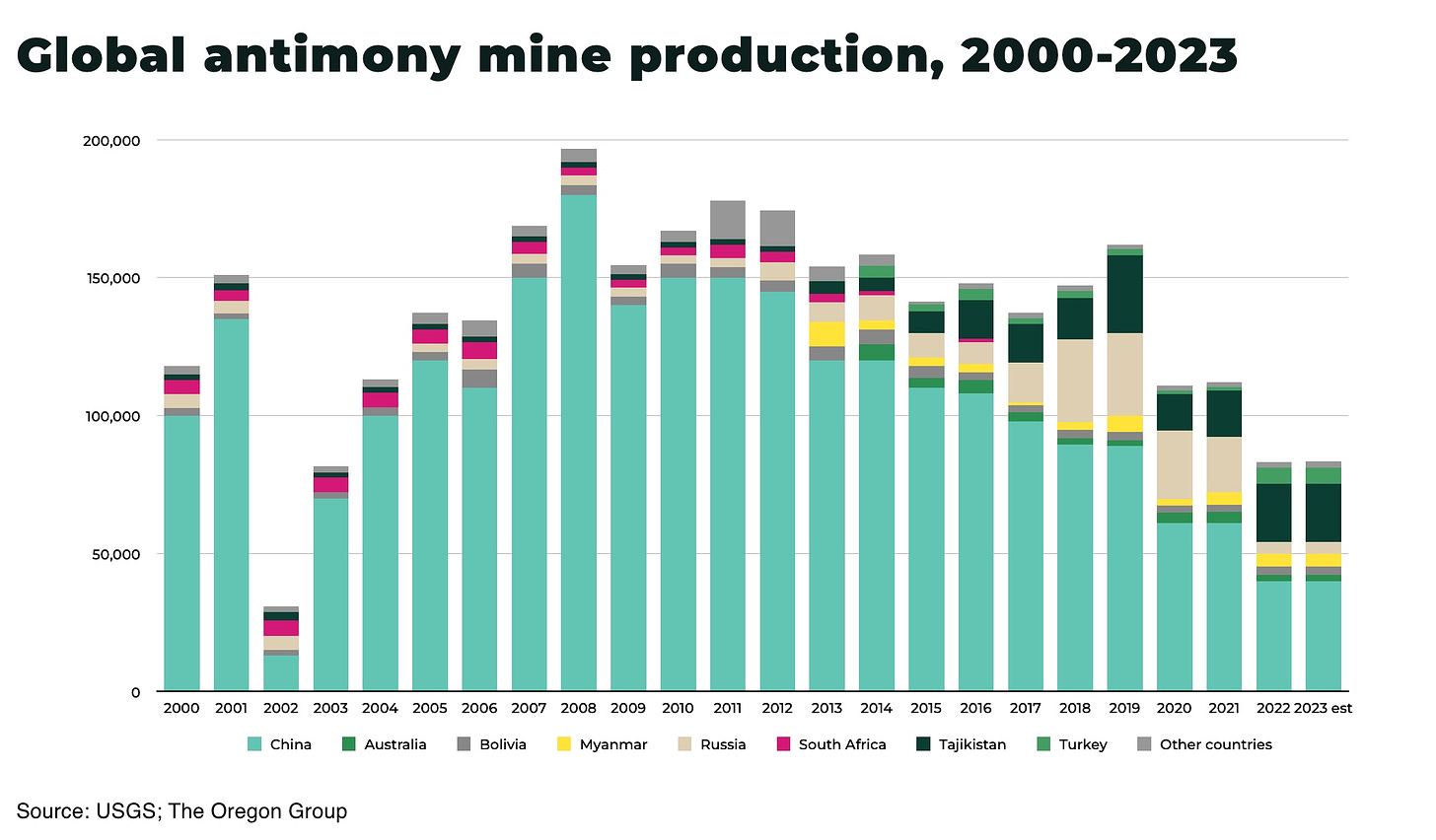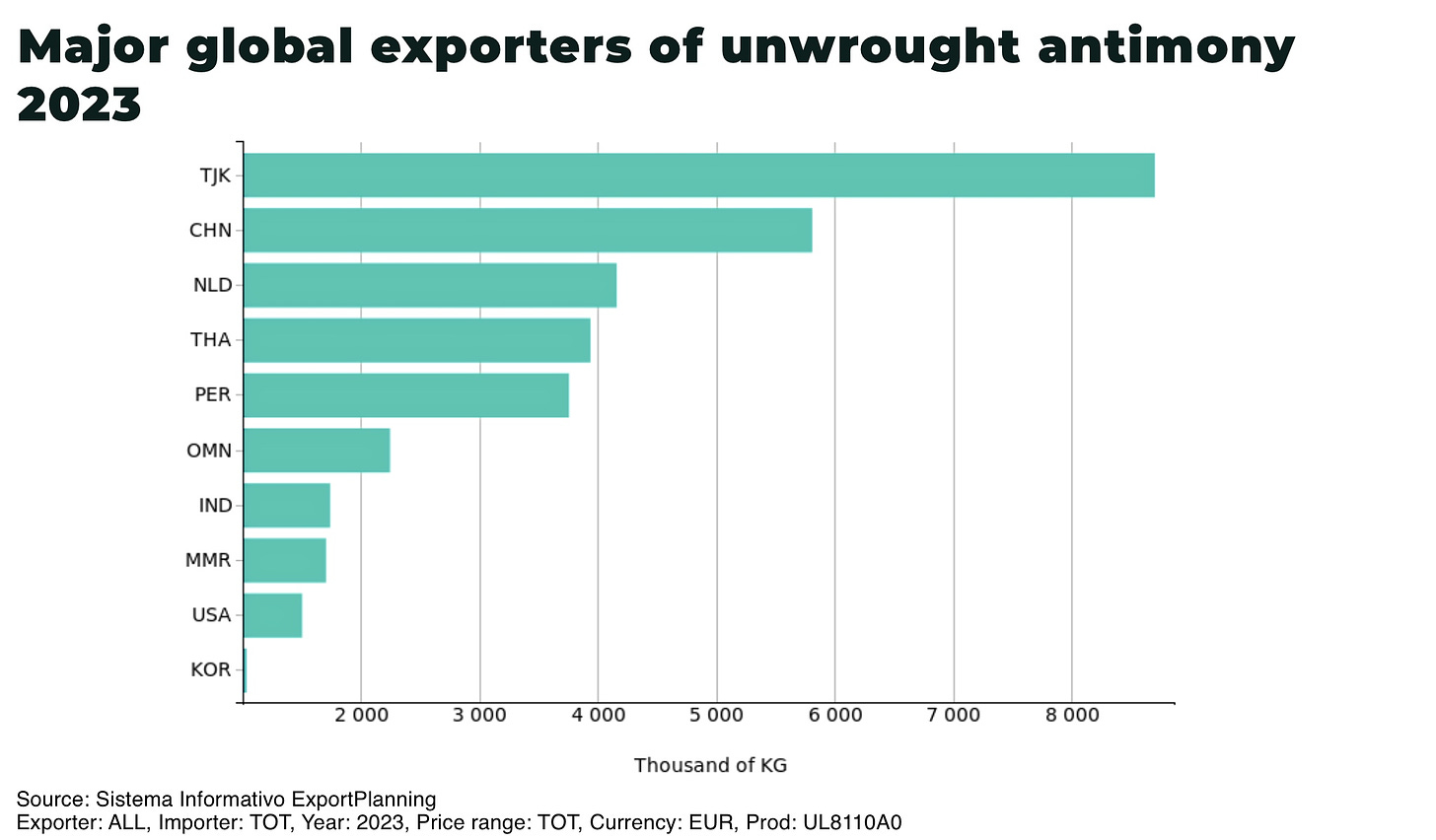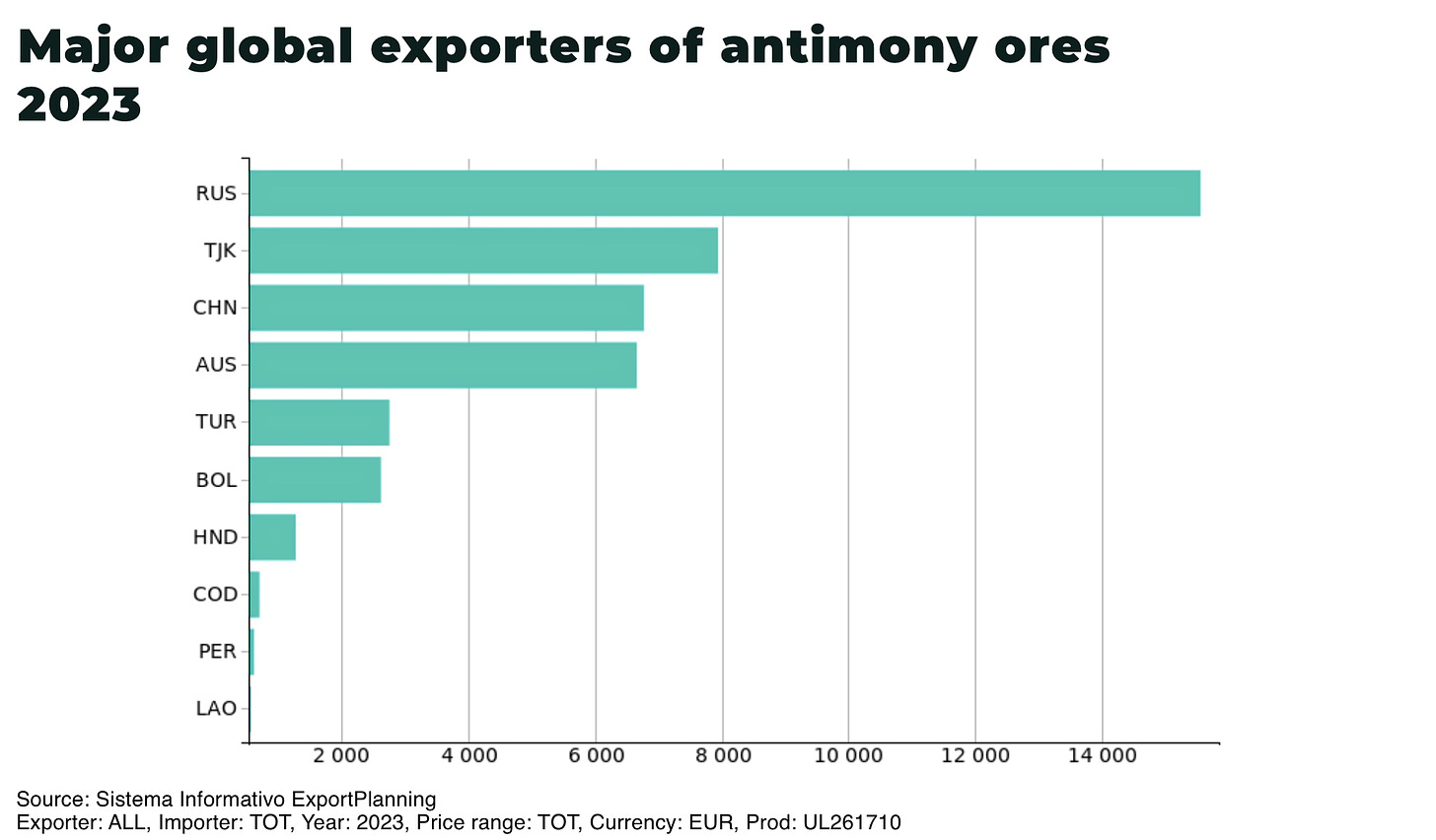Why are antimony prices exploding - https://theoregongroup.com/energy-transition/market-trends/why-are-antimony-prices-exploding/A supply shortage has triggered the steepest rally in price “ever recorded” in the global antimony market since April, according to FastMarkets who began recording prices from January 1980.
In May, prices reached US$17,588.88 per metric ton of antimony ingot, up 54% in 2024, according to the Shanghai Metals Exchange; prices in Europe reached US$22,700 a ton on June 14, up more than 75% on 2023.
And now China has announced it will impose export limits on antimony because of “national security.”
The reason: an extreme shortage of supply from China, Russia, and south east Asia, while demand from solar power soars.
“Antimony is becoming a crazy dangerous market… It is hurting the industry, causing irreparable damage” — a trader told Argus, noting that consumers are getting hit by the higher prices and reduced availability
What is antimony
Antimony is a silver-grey metalloid (exhibiting properties of both metals and nonmetal). Its main uses include:
- flame retardant, as antimony trioxide, for plastics, textiles and other products such as electric batteries and wind turbines
- lead-acid batteries, to improve tensile strength and charging capacity
- high-quality glass, used to remove trapped air bubbles in the glass
- photovoltaic (PV) glass, used as a clarifying agent to improve efficiency of solar cells
- alloy agent, to harden lead and increase durability of other metal alloys
- semiconductor production, including in printed circuit boards, infrared detectors and diodes
- military equipment, in the manufacture of armor piercing bullets, night vision goggles, infrared sensors, precision optics, laser sighting, explosive formulations, hardened lead for bullets and shrapnel, ammunition primers, and more
Antimony’s importance is underlined by its listing as a critical mineral in the US, EU, Japan and Australia.
Antimony demand
In 2011, nearly 90% of antimony was used as either flame retardants or in lead-acid batteries. However, high prices and technological efficiencies in both flame retardants and lead-acid batteries has meant that demand steadily declined.
Estimates suggest antimony’s use as a flame retardant now accounts for approximately half of global demand.
Instead, two new dynamics are pushing up demand:
Solar
Antimony is used as a clarifying agent in photovoltaic (PV) glass — and, in 2023, solar PV installations reached record levels in China (already one of the world’s biggest consumers of antimony).
According to China Merchants Securities, antimony demand from the photovoltaic sector is forecast to increase to 68,000 tons in 2026 from 16,000 tons in 2021, with the sector’s share in total consumption rising to 39% from 11%.
Project Blue estimates solar PV will account for more than a third of non-metallurgical demand by 2050.
This is already impacting supply chains with, for example, some antimony smelters reportedly switching to process the raw material into sodium antimonate – used in PV glass to improve the efficiency of solar panels — rather than making ingot for conversion into antimony trioxide for in flame retardants.
“With a growth rate of 30% year on year, the demand for antimony in the photovoltaic industry has changed the supply-demand balance of the antimony industry” — Kang Dongsheng, chairman of major Chinese antimony producer, Hsikwangshan Twinkling Star Co Ltd told FastMarkets
Ammunition
In the US, the main primary consumption of antimony in 2023, were:
- 43%, metal products, including antimonial lead and ammunition
- 35%, flame retardants
- 22%, nonmetal products, including ceramics and glass and rubber products
With global arms production and geopolitical tension rising significantly, antimony’s primary importance is increasingly bound up in national security priorities.
For example, the new export controls by China on six types of antimony-related products, including antimony ore, antimony metals and antimony oxide, are effective from September 2024 — and being imposed “in order to safeguard national security and interests, and fulfil international obligations such as non-proliferation”, China’s Commerce ministry said in a statement.
And not all of this demand will be shown in the data, as Christopher Ecclestone, principal and mining strategist at Hallgarten & Co, told Reuters: “clandestine” western military buying is also driving antimony demand. ”The supply crisis is not going away and the military have bottomless pockets,” he said.
Supply
China
Total global antimony mine production in 2023 was approximately 83,000 tonnes. The largest producer, by far, is China — but this is steadily decreasing.
- in 2000, China produced 100,000 tonnes, out of a global total of 121,000 tonnes
- in 2024, China produces 40,000 tonnes, out of a total of 83,000 tonnes
Not only is China’s percentage falling, but supply elsewhere is not acting as a substitute for the fall in China production.
China Customs data shows that the country imported 890 tonnes of antimony in 2023, but the total is likely to be significantly higher as gold-antimony concentrates were reportedly imported as “gold”.
According to Project Blue estimates, the industry fell into a deficit in 2021 and for the first time in history, Chinese ingot smelters had become critically reliant on imported antimony concentrates. New supply from Russia’s top gold producer, Polyus, helped lift the deficit in 2023 — but the market is forecast to fall back into deficit in 2024.
The problem for China is that reserves are increasingly depleted, as well as rising costs with tighter environmental regulation and decreasing ore quality.
For example, environmental inspections were conducted in Hunan province from March to June 2024 leading to closure of illegal mines.
This is now putting pressure on other global suppliers.
Russia
According to the USGS, Russia has the second largest antimony reserves in the world, at 350,000 (after China’s 640,000), and is currently the fifth largest producer in the world.
Russia also operates one of the largest antimony mines in the world.
The Olimpiada mine in Russia, operated by Polyus, is primarily a gold mine but was responsible for more than 20% of global antimony mine supply in 2023.
This level of production means Polyus has considerable influence over the price of antimony when, for example in 2023, Polyus helped bring the market out of deficit. Several of China’s main antimony miners and some gold smelters have reportedly adjusted processing flow sheets to accommodate lower-grade antimony and higher-grade gold concentrates from Polyus.
However, Polyus has been subjected to Western sanctions, imposed after Russia invaded in Ukraine in 2022, disrupting supply to the West.
Myanmar
From 2013, Myanmar emerged as a significant and consistent exporter of antimony, the world’s fourth largest producer in 2023, with approximately 4,600 tonnes.
However, just as with supply concerns over tin from the region, so the civil war in Myanmar has disrupted supply chains, key trade routes and small-scale artisanal mining. Sources have told Fastmarkets that smelters in southeast Asia are offering lower quantities of antimony metal for sale at higher prices, since December 2023.
Tajikistan
Tajikistan is the world’s second largest antimony producer, producing 21,000 tonnes, with the “Anzob” company (established as the Tajikistan-U.S. joint venture in 2005) a significant seller of antimony to Europe.
China’s metals mining firm Huayu Mining also has a joint venture with Tajik Aluminium Co (Talco) with a gold-antimony mine in the country, but has been hit by delays.
USA
The USA has not produced antimony domestically since the closure of its last mine in Idaho in 2001, and stockpiles in 2003 were reportedly just 1,100 tons (vs consumption of 23,000 tons).
But, this year, Perpetua Resources received a letter of interest from the US Export-Import Bank (EXIM) for a loan worth up to US$1.8 billion to develop an antimony and gold mine in northern Idaho. It comes after the Department of Defence, through the Defense Production Act Investments Program, awarded US$24.8 million to complete an environmental study and US$60 million to fund the permitting process.
According to the company, the mine has the capacity to meet 35% of US demand in the first 6 years.
Perpetua plans to begin production 2028, hoping final permits are signed this year but, with China’s new restrictions on exports, the company is looking at starting operations sooner.
“We are looking at things that we can do during construction to get antimony out the door sooner for some of these strategic needs,” Jon Cherry, Perpetua’s CEO, told Reuters.
This is a key part of the US strategy to de-risk supply chains of critical minerals, especially from China.
Conclusion
Antimony supply faces both a short-term volatility squeeze and long-term structural deficit.
In the short- to medium- term supply from major producers, such as Russia and Myanmar, is extremely volatile due to sanctions and regional conflict.
And, production and reserves in China, still the world’s largest producer, are falling.
(the high gold price also throttles the production of antimony as many gold-antimony mines, such as Russia’s Polyus, focus on gold production)
Meanwhile, demand — primarily by solar and military needs — continues to grow.
The removal of sanctions on Russia and/or an end to the conflict in Myanmar would provide short-term relief (eg stockpiles from Polyus) — but new supply will take years, if not decades, to come online. And, as the new restrictions by China highlight, this is a long-term problem.
- Forums
- ASX - By Stock
- Antimony
Why are antimony prices exploding -...
-
-
- There are more pages in this discussion • 2 more messages in this thread...
You’re viewing a single post only. To view the entire thread just sign in or Join Now (FREE)
Featured News
Add WA8 (ASX) to my watchlist
 (20min delay) (20min delay)
|
|||||
|
Last
5.8¢ |
Change
-0.001(1.69%) |
Mkt cap ! $43.50M | |||
| Open | High | Low | Value | Volume |
| 5.8¢ | 5.8¢ | 5.7¢ | $24.51K | 426.3K |
Buyers (Bids)
| No. | Vol. | Price($) |
|---|---|---|
| 1 | 50000 | 5.8¢ |
Sellers (Offers)
| Price($) | Vol. | No. |
|---|---|---|
| 5.9¢ | 209198 | 3 |
View Market Depth
| No. | Vol. | Price($) |
|---|---|---|
| 1 | 200000 | 0.058 |
| 1 | 100000 | 0.057 |
| 4 | 331571 | 0.056 |
| 4 | 646363 | 0.055 |
| 3 | 451500 | 0.054 |
| Price($) | Vol. | No. |
|---|---|---|
| 0.059 | 155451 | 2 |
| 0.060 | 270000 | 3 |
| 0.061 | 121170 | 2 |
| 0.062 | 361290 | 3 |
| 0.063 | 67745 | 1 |
| Last trade - 14.24pm 08/10/2024 (20 minute delay) ? |
Featured News
| WA8 (ASX) Chart |
